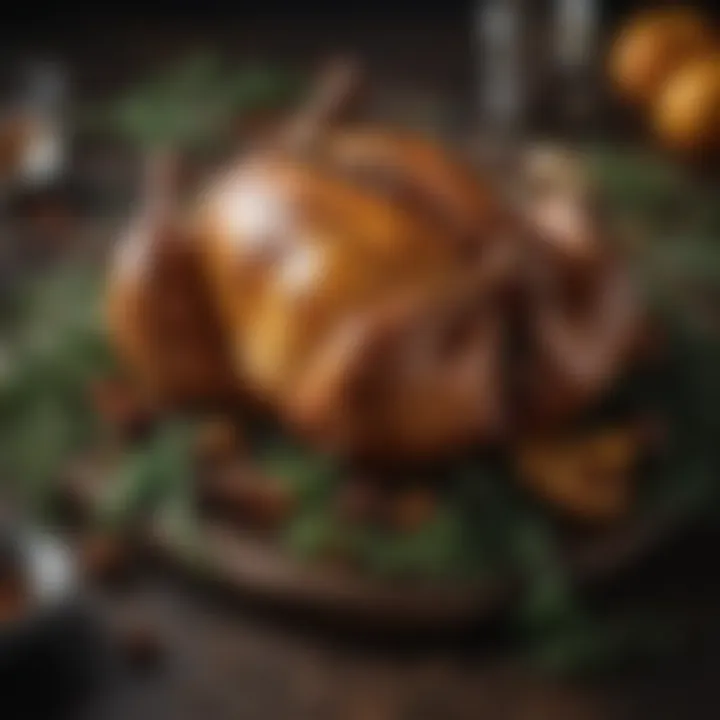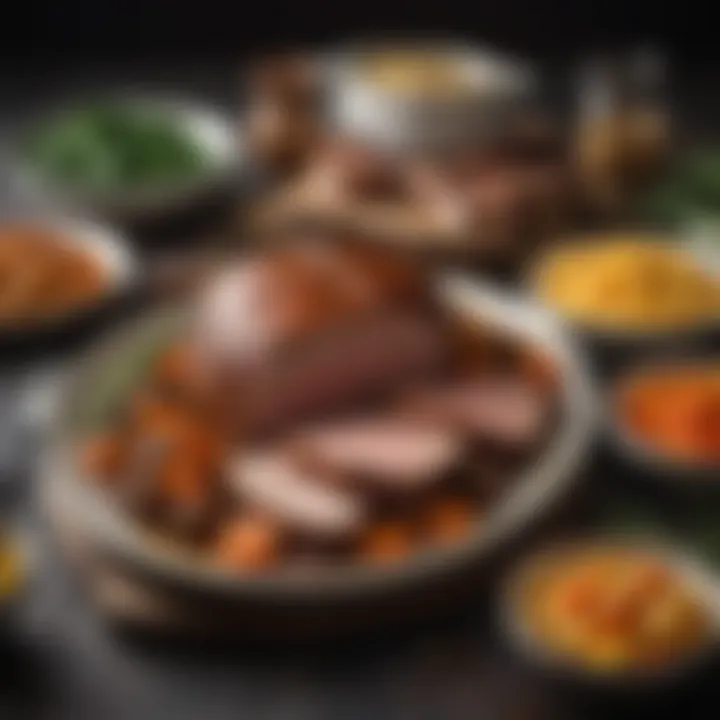Mastering the Art of Baking a Roast in the Oven


Intro
Roasting is often seen as an age-old technique reserved for seasoned cooks, but with the right approach, anyone can master it. Baking a roast in the oven merges art with science, transforming a simple piece of meat into a flavorful centerpiece for any meal. Understanding the subtleties of this culinary process not only enhances your cooking repertoire but also builds confidence in the kitchen.
This guide aims to dissect the various elements involved in roasting, from selecting the perfect cut to achieving that coveted, mouthwatering flavor and texture. A bit of patience goes a long way here, and by engaging with the nuances of each step, you'll learn how to create a roast that can impress even the most discerning palates.
As we journey through this guide, keep in mind that every cook has their own style, and while techniques can be similar, personal touches make all the difference. Now, let’s move on to the exciting part — the roasting itself!
Recipe Overview
Recipe Name
Classic Herb-Crusted Roast Beef
Description of the Dish
Imagine a beautifully browned roast, the aroma wafting through the kitchen, inviting friends and family to gather. This Classic Herb-Crusted Roast Beef promises rich flavors brought out by a mix of fresh herbs and its own inherent juices. This dish encapsulates comfort food and elegance, making it perfect for family dinners, holidays, or any special occasion.
Ingredients
- 3-4 lbs (1.4-1.8 kg) beef roast (like ribeye or sirloin)
- 2 tablespoons olive oil
- 4 cloves garlic, minced
- 2 tablespoons fresh rosemary, chopped
- 2 tablespoons fresh thyme, chopped
- 1 tablespoon salt
- 1 teaspoon black pepper
- 1 cup beef broth
Special Notes on Ingredients
- Beef Cuts: Choose a cut that fits your taste. Ribeye offers excellent marbling for a rich flavor, whereas a leaner cut like sirloin is a healthier option.
- Herb Variations: If fresh herbs are challenging to find, dried versions can also work, but remember that dried herbs are more potent. Use about one-third of the amount called for fresh herbs.
- Seasoning: Adjust salt and pepper to cater to your personal preference, and consider adding a dash of paprika for a hint of smokiness.
Fresh, high-quality ingredients always yield better results, so hunt for them at your local market or specialty store. Let's move ahead to elevate our understanding of preparation techniques that will take your roast from good to absolutely fantastic.
Understanding the Basics of Oven Roasting
To gain mastery over the art of baking a roast, one must first lay a solid foundation in the essentials of oven roasting. This process is not merely about cooking meat; it encompasses techniques that produce flavor, texture, and aroma that awaken the senses. Knowing the basics helps home cooks avoid common pitfalls and elevates the quality of their culinary endeavors.
Defining Roasting
Roasting, at its core, is a cooking method that involves dry heat circulating around the meat. This method results in a beautifully browned exterior while maintaining a juicy interior. The key here lies in temperature control and timing. Unlike grilling or broiling, where direct heat is applied, roasting promotes a slow cooking process, allowing for an even cook and enhancing natural flavors. Whether it's a bottom round roast or a well-marbled ribeye, understanding this definition provides clarity on how to approach different cuts.
Origins of Oven Roasting
The origins of oven roasting are deeply rooted in the history of cooking. It is believed to date back centuries, possibly to ancient civilizations where meats were cooked over open flames or in hot coals. With time, the advent of the modern oven revolutionized this process. The desire to achieve perfection in texture and flavor led to various interpretations worldwide, adapting local ingredients and methods. From the hearty roasts of medieval banquets to today's simpler, home-cooked meals, oven roasting signifies not just a method but an experience woven into culinary heritage.
Types of Roasts Suitable for Baking
In the vast universe of cooking, diverse meats can be roasted with varying results. Familiarizing oneself with different types of roasts prepares one for any culinary adventure. Here, we categorize some popular roasts to make informed choices:
Beef Roasts
Beef roasts, such as chuck or prime rib, stand as stalwarts in the realm of roasting. Their unique characteristic lies in the fat content that renders during cooking, enhancing flavor and tenderness. This makes beef a favored choice, especially for gatherings. Additionally, the marbling in certain cuts, like ribeye, brings richness that can't be easily replicated. However, improper cooking can turn succulent beef into a chewy disappointment if not monitored closely.
Pork Roasts
When it comes to versatility, pork roasts shine bright. Cuts like pork loin or shoulder can absorb marinades well and provide a different flavor profile. The hint of sweetness in pork can balance spices and herbs, making it an ideal canvas for various seasoning techniques. The only caveat here is that pork must be cooked thoroughly to ensure safety, but overcooking can lead to dry outcomes.
Lamb Roasts
Lamb roasts, with their distinct taste, are beloved in many cultures. Cuts such as leg or rack of lamb carry a bold flavor that's often complemented by robust herbs like rosemary and garlic. The density of lamb makes it a premium choice for those looking to impress at a dinner party. However, lamb can be polarizing; its strong flavor doesn’t appeal to everyone. Thus, understanding your audience becomes critical.
Poultry Roasts
Poultry roasts, be it chicken or turkey, feature prominently on festive tables. The key characteristic is their flexibility—being able to adapt one’s seasoning choices to various cuisines. Chicken, for instance, can take on flavors from zesty Mediterranean rubs to classic herb blends. While typically easier to cook, poultry also risks drying out if not monitored properly, especially at higher temperatures.
In summary, understanding the basics of oven roasting equips cooks with the knowledge to select the right cut and method. By identifying the specific qualities of beef, pork, lamb, and poultry roasts, one can responsibly approach the art of roasting, ensuring that each dish created is an enjoyable experience for both the cook and the diners.
Selecting the Perfect Cut of Meat
When it comes to baking a roast, the cut of meat you choose is fundamentally important. Selecting the right piece isn’t just a matter of taste; it lays the groundwork for how your roast will turn out. A great roast can turn a family meal into a feast, while a poor cut can leave you stuck chewing on shoe leather. Therefore, understanding the nuances of meat selection will arm you with the knowledge needed to tantalize your taste buds.
Understanding Meat Grades
The grading of meat can significantly affect both quality and flavor. In many countries, but especially in the U.S., the USDA designates grades such as Prime, Choice, and Select. Each of these carries its own merits.
- Prime: This one’s the cream of the crop, boasting a high level of marbling. You’ll find it mostly in high-end restaurants. If a moist, tender roast is what you aim for, Prime is your best bet.
- Choice: Next on the list, this grade offers decent marbling, thus delivering a good taste without breaking the bank. It’s a solid option for home cooks wanting to impress, but not willing to sell the farm.
- Select: Lastly, while Select can still be quite palatable, it lacks the fat needed for robust flavors and juicy texture. Cooks may need to be extra careful, perhaps even consider marinating, to avoid a dry finish.
Being knowledgeable about meat grades enables you to make an informed choice that aligns with both your budget and culinary ambitions.
Bone-In vs. Boneless


The debate of bone-in versus boneless is centuries old, each with its loyal followers. Choosing between these two options depends largely on your cooking style and the culinary outcome you desire.
- Bone-In: Leaving the bone in can add depth of flavor to the roast. Bones conduct heat and help to maintain moisture during cooking. It's like having a built-in natural basting system. Plus, who doesn’t love the drama of a spindly bone sticking out of a glorious hunk of meat?
- Boneless: On the other hand, a boneless cut is easier to slice and often cooks more evenly. This is particularly advantageous if you're aiming for a clean presentation. A well-turned-out roast free of bones can provide an elegant dining experience.
Evaluating your goals with the roast—whether ease or flavor dominance—is key to making the right choice between bone-in and boneless.
Grass-Fed vs. Grain-Fed Options
In the world of meat, the grass-fed versus grain-fed debate echoes among chefs and home cooks alike. Each method yields distinct flavor profiles and cooking characteristics, so understanding these differences can help steer your selection.
- Grass-Fed: Often hailed for its healthier omega-3 fatty acid profile, grass-fed meat tends to have a robust, slightly more complex flavor. It can also be leaner, making it a fantastic choice if you’re looking to cut down on fat. However, because of its lower fat content, it can dry out more easily if overcooked. So, if you opt for grass-fed, stay vigilant with temperature checks!
- Grain-Fed: Alternatively, grain-fed beef, which is typically corn-fed, often has a richer, buttery flavor due to the increased marbling. It tends to be more forgiving when it comes to doneness, giving you a wider margin for error. If you’re new to roasting, this could soften the learning curve.
Preparation Techniques for Baking a Roast
When it comes to roasting a perfect piece of meat, the preparation method holds just as much weight as the cooking process itself. Whether you are standing in your kitchen ready to tackle a mouthwatering beef roast or planning a more delicate poultry dish, the techniques employed beforehand can enhance the flavor, texture, and overall enjoyment of the meal. Preparation is not just about throwing the meat in the oven; it’s about creating a harmonious experience that begins long before the first bite.
Marinades and Rubs: Building Flavor
Flavor is the soul of any roast, and marinades or rubs play a pivotal role in achieving a satisfying depth. These techniques not only impart seasoning but also help in tenderizing the meat, making it more succulent and inviting.
The Role of Acidic Components
Acidic components, like vinegar, citrus juices, or yogurt, serve a critical purpose in marinades. They break down proteins, softening the meat while infusing it with incredible flavors. This tenderization is crucial, particularly for tougher cuts of meat where a little love from acidic ingredients can work wonders.
Using acidic elements not only enhances flavor but also balances the richness of fattier meats. For instance, a lemon juice marinade can cut through the heavy nature of a pork roast, leaving it fresh and vibrant. The key characteristic of acidic components is their capacity to create a tender, juicy result that enhances the overall experience of your dish.
Nonetheless, there is a fine line to tread. Marinades with too much acidity can overpower the meat, taking things from zesty to overbearing, so experimenting to find the right balance is vital.
Choosing the Right Spices
Selecting spices for your marinade or rub can feel like an overwhelming task, but nailing down the right ones is what adds that distinct touch to your roast. Spices can transform ordinary meat into a flavorful masterpiece. Think of things like rosemary, garlic, and smoky paprika. Each brings out different flavors and aromas, enhancing the natural tastes of your meat.
The importance of this selection lies in its ability to work synergistically with the meat itself. A well-rounded spice blend should marry with the meat's characteristics, whether it’s rich beef or delicate chicken. However, people sometimes miss the mark, using too many spices all at once, which can lead to a confused palate rather than a harmonious dish.
The unique feature of picking the right spices is simply striking that sweet spot where they not only carry their weight, but complement each other beautifully. A balanced spice profile can elevate your roast from good to unforgettable.
Seasoning Fundamentals
Good seasoning can be the difference between a dish that merely satisfies and one that leaves an impression. It often begins with salt, which, when used properly, enhances the natural flavors of the meat while helping to retain moisture during the cooking process. Consider using kosher salt or sea salt – both can bring a texture and flavor that acts differently than standard table salt.
Beyond salt, employing ground or whole spices can bring layers of flavor to your meat. Allowing the seasoning to penetrate the meat for a while can lead to a much more flavor-forward roast, creating that mouthwatering experience you crave.
The Importance of Room Temperature
Before you pop your meat into the oven, letting it come to room temperature is another crucial step. Cold meat in a hot oven often leads to uneven cooking, where the outside may become overdone while the inside remains undercooked. By allowing your roast to sit out for around 30 minutes, you prepare it for more even cooking.
This friendly pre-cooking ritual helps to solidify a golden crust on the outside while allowing the interior to reach its ideal doneness. Overall, the right preparation techniques can sure make your roasting journey not just successful but enjoyable, adding layers of flavor into each and every bite.
Oven Setup and Temperature Control
When it comes to baking a roast in the oven, the setup and temperature control play a crucial role in achieving that desired outcome. You could have the most exquisite cut of meat and the perfect marinade, but if your oven setup is off kilter, you might as well be tossing your ambitions out with last week's leftovers. Getting these elements right ensure that the roast is cooked evenly, retains moisture, and locks in those rich flavors that turn a simple meal into something unforgettable.
Choosing the Right Oven Rack Position
Selecting the correct position for your oven rack can significantly influence the cooking process. Positioning your roast too high could result in over-browning or even scorching, while a low position might lead to uneven cooking.
Generally, placing your rack in the middle provides a nice balance of heat circulation. This allows for even cooking all around. If your roast is particularly large, make sure the rack isn't crowded; air needs space to move around for proper heat distribution. If a recipe calls for browning first, try using a higher position, but carefully monitor it to prevent any burnt flavors from creeping in.
Preheating: Why It Matters
Preheating your oven isn't just a recommendation; it's essential to achieving the roast you desire. Skipping this step may lead to inconsistent cooking and affect the roast's texture. A properly preheated oven ensures that the external layers of your meat can sear immediately, creating a beautiful crust that locks in juices.
Typically, allow your oven to reach at least 20 to 30 degrees above your targeted cooking temperature before placing your roast inside. This gives those lovely Maillard reactions a chance to start right from the get-go, leading to that delectable browning of the meat.
Understanding Different Cooking Methods
When it comes to roasting, understanding various cooking methods is paramount. Each method has unique characteristics that yield different results in terms of flavor and texture.
Conventional vs. Convection Cooking
Conventional cooking utilizes radiant heat that comes from the oven walls, which is typical for most standard ovens. Here, the heat primarily rises from the bottom of the oven, heating the air and then circulating it. This method is generally considered slower and can result in uneven cooking if not monitored closely. It's a favored choice for certain cuts of meat as it can help develop a lovely crust while the inside remains tender.
On the other hand, convection cooking has its own charm. It involves a fan that circulates hot air within the oven. This not only speeds up cooking time but results in a crispy outer layer while keeping the inner parts moist. While it’s efficient, care must be taken not to over-dry the roast, particularly with lean meat types, as there is less moisture in the environment.
Using Steam for Moisture
The use of steam in cooking is a game-changer that a lot of home chefs overlook. Adding steam can profoundly influence the texture and juiciness of your roast. It helps in maintaining moisture, thus preventing that dreaded dry roast. By introducing steam into the oven, you set the stage for an even cook while maintaining a succulent texture.


You can create this effect by placing a small pan of water in the oven while your roast cooks. However, the drawback is that it can complicate your monitoring of the roast’s internal temperature. Keep a close eye to ensure the steam complements rather than overwhelms your cooking process.
Remember: Proper setup and temperature control can take your roasting game to unparalleled heights, ensuring consistently delicious results.
The Baking Process: Timeline and Techniques
The baking process is where a roast truly comes to life. It's not just about throwing a piece of meat into the oven and expecting magic; it’s a carefully orchestrated symphony of time, temperature, and technique. Understanding the nitty-gritty of this process can make the difference between a mediocre meal and an extraordinary feast. From determining the perfect cooking time to the importance of vigilant monitoring, these techniques ensure a beautifully cooked roast that’s both succulent and flavorful.
Calculating Cook Time
When it comes to baking a roast, the first thing on the agenda is calculating the cook time. This isn’t an arbitrary number folks, but a science underpinned by both the cuts of meat and oven temperature. Generally, the recommendation is to roast meat for about 20 minutes per pound at a temperature of 325°F (163°C). For instance, a 4-pound pork shoulder might require somewhere around 80 minutes, while a hefty beef brisket could take upwards of 120 minutes.
However, other factors come into play too:
- Type of Meat: Different meats have varying densities, which affects cooking time.
- Bone-In vs. Boneless: Bone-in cuts usually take longer due to the bone’s heat retention.
- Oven Accuracy: Not all ovens are created equal. Using an oven thermometer can provide peace of mind that the temperature is just right.
Mistakes in estimating cook time can lead to disappointment. Thus, keeping a close eye on the clock and setting timers can be your best allies.
Basting: Its Role During Cooking
Basting might feel like an extra step, but it plays a crucial role in retaining moisture and enhancing flavor. As the roast cooks, its surface can dry out, especially if it’s well-marinated or seasoned. By basting, you’re essentially showering your roast with its own flavorful juices or additional liquid like broth or wine, helping to develop a beautiful crust and keep the inside tender.
Some tips for effective basting include:
- Frequency: Basting every 30 minutes is usually sufficient. Too often may cause heat loss in the oven.
- Technique: Use a baster or a ladle, and remember—scooping from the bottom gives the most concentrated flavor.
- Combinations: Sometimes, adding herbs or flavored oil to the baste can create an aromatic experience that doesn’t just taste good but smells divine.
Good basting can elevate a roast from common to memorable.
Monitoring Internal Temperature for Doneness
The pièce de résistance of baking a roast is ensuring it’s perfectly cooked. You could go by color alone, but this is risky. Instead, invest in a reliable meat thermometer to check the internal temperature. Different meats have different safe cooking temperatures:
- Beef: 145°F (63°C) for medium rare; 160°F (71°C) for medium.
- Pork: The USDA recommends 145°F (63°C) followed by a three-minute rest.
- Poultry: Aim for at least 165°F (74°C) to ensure safety.
Inserting the thermometer into the thickest part of the meat, without touching the bone, will yield the best results. This vigilance can be the key to avoiding overcooking, which tends to toughen meat.
"Remember, meat keeps cooking even after it’s removed from the oven—carryover cooking can raise the temperature by at least 5°F (3°C)."
Focusing on these details during the baking process not only hones your skills in cooking but transforms the meal experience for everyone sitting around the table. You'll find that these techniques intertwine, crafting a roast that not only satisfies hunger but stirs memories of shared meals.
Common Mistakes to Avoid during Roasting
Roasting can be an art and a science, and while many home cooks excel at it, some common pitfalls could turn a potential masterpiece into just another meal. Understanding these missteps can vastly improve the quality of your roast, ensuring that every bite is as delectable as you envisioned. Being mindful of these mistakes offers not only a more flavorful dish but also a satisfying cooking experience, reinforcing confidence in your skills.
Over-seasoning and Overcooking
In the world of roasting, it’s easy to fall into the trap of thinking more is always better. This is especially true when it comes to seasoning and cooking time. First off, let’s talk about over-seasoning. It’s often believed that piling on salt and spices can amp up flavor. However, this might lead the roast to be overwhelming rather than tantalizing. The delicate balance should ideally enhance the natural flavor of the meat, not mask it. Start small. You can always add more, but taking it away is next to impossible.
To kick flavor into high gear without going overboard, consider using fresh herbs or marinades with a hint of acidity. These can bridge flavors beautifully without overwhelming. And now, for overcooking—this is the kiss of death for any roast. Cooking it too long will lead to dry, tough meat, especially with leaner cuts. Always rely on an instant-read thermometer to check doneness. This is a savior when cooking meats like pork or chicken, which have specific internal temperature guidelines.
Skipping the Resting Stage
Much like a highly anticipated event, patience is crucial once your roast is out of the oven. Skipping the resting stage often dampens the overall quality of the dish. When you pull a roast straight from the heat, all the delicious juices are still bubbling and active inside. If you slice straight into it, those flavorful liquids will escape onto the cutting board, leaving an uninspired meal on your plate.
As a rule of thumb, let your roast rest for at least 15-30 minutes before slicing. This allows the juices to redistribute evenly throughout the meat, ensuring that each slice is succulent and flavorful. Cover the roast loosely with foil during this time to retain warmth. It’s a simple step that can significantly elevate your dining experience.
Using a Non-Resistant Baking Dish
Imagine the horror of putting your carefully prepared roast into a flimsy baking dish, only to find it warped or cracked by the heat. This leads to not just frustration but also potential safety issues in the kitchen. Using a non-resistant baking dish is a mistake that can seriously affect your roasting experience.
Choosing the right dish is essential. Opt for materials like cast iron, stainless steel, or heavy-duty glass that can withstand high temperatures. These materials conduct heat evenly, leading to a better crust and overall cooking. They also typically retain heat well, which helps maintain the temperature, especially when you leave the roast to rest.
"The right tools make all the difference, turning the mundane into the extraordinary."
In summary, it’s important to remember that mastering the art of roasting entails avoiding common errors such as over-seasoning, neglecting resting time, and using inadequate cookware. With these refinements, your roast can transform from ordinary to extraordinary, delighting the palates of friends and family alike.
Presenting Your Roast: Aesthetic Considerations
Whether it's a holiday feast or an ordinary Sunday dinner, how you present a roast can elevate the entire dining experience. Presentation is more than just looks; it sets the stage for taste and enjoyment. The visual appeal of a well-presented roast not only showcases the effort you put into cooking but also tantalizes the senses of your guests before they even take a bite. In essence, it creates an atmosphere, weaving an intricate tapestry of sights and smells that draw everyone to the table.
First, consider how the roast is sliced. Uniform, skillfully-cut slices show care and attention to detail. When the slices are even, it speaks volumes about the cook's expertise. Deep down, everyone wants to experience the juxtaposition of nicely roasted meat with an appealingly presented side dish. Additionally, the rich juices that may flow from each slice can mesmerize and yet, hint at the flavors awaiting in every bite.
It's important, too, to arrange the roast alongside its accompaniments. Color contrast plays a vital role here; vibrant greens, deep earth tones, and splashes of red can transform a simple platter into a piece of art. Think about the space you’re using. A large wooden board may evoke rustic charm, while a sleek white platter can offer a modern twist. Whatever your choice, make sure it complements the roast and the rest of your table setup.
The first bite is taken with the eyes; make that first impression count!
Slicing Techniques for Presentation


Slicing plays a crucial role in making the roast shine on the plate. Aim for precision—each cut should be about half an inch thick for optimal blend of juiciness and tenderness.
When slicing, use a sharp knife, and a gentle sawing motion ensures clean cuts. Start at one end and work your way to the other, making sure to cut against the grain to maintain tenderness. This technique ensures the roast doesn’t look like it's been through a battle! Adding a sprinkle of fresh herbs as you slice can also elevate the visual aspect.
Choosing Accompaniments and Sides
Offering the right accompaniments not only rounds out a meal but also enhances the overall aesthetics. Here's a closer look at two musical partners in your roast's performance:
Vegetable Pairings
Pairing vegetables with your roast is not only perfect for balancing flavors but also enhances overall presentation. Think of roasted carrots with their bright orange hue, or dark leafy greens that add depth. The key characteristic about vegetable pairings is their ability to offer both color and nourishment to your plate.
When you serve vegetables alongside your roast, you're adding not just a side but a backdrop that elevates the dish visually. Their unique texture—crunchy or tender—can create a dynamic on each plate. Plus, seasonal vegetables often mirror flavors found in marinades, creating a harmonious balance.
If you opt for glazes or seasoned vegetables, just keep an eye on the seasoning; overdoing it can overwhelm the delicate notes of the meat. With a beautiful medley of colors and flavors, your roast and the surrounding veggies will surely catch eyes—and appetites!
Starches and Sauces
Now let’s not forget about starches and sauces. From creamy mashed potatoes to fluffy rice, these are often the unsung heroes of the dinner plate. Their role is fundamental in providing a filling and satisfying component. This particular aspect of roasts is often highlighted by the sauces prepared—be it a savory gravy or a rich red wine reduction.
Mashed potatoes, for instance, not only absorb the juices of the roast beautifully but also serve a calming white palette that can balance the dish. Another unique feature of starches is their ability to lend a satisfying mouthfeel, enhancing each bite. Choices can be abundant—polenta, couscous or good ol’ fashioned crusty bread also can shine in the spotlight.
Combing through various sauce options, a well-thought-out choice can enrich flavors without overshadowing them. However, it’s wise to be cautious not to ladle too much sauce—keeping it delicate ensures the roast remains the star of your culinary show.
Garnishing for Visual Appeal
Lastly, tasteful garnishing can top off your presentation. Fresh herbs like parsley, rosemary, or thyme can add pops of green that catch the eye. Don't overdo it; just a light sprinkle can make all the difference. Also, citrus slices not only add color but can provide an aromatic lift too.
Ultimately, remember that the goal of presentation is to entice the eater, to tell a story before they dig in. Each element should come together to play their part in creating a memorable, beautiful roast experience that invites others to the table.
Exploring Flavor Pairings and Wine Suggestions
When it comes to baking a roast, flavor is everything. The essence of a truly memorable dish often resides not just in the cooking method but in the careful orchestration of flavors that dance together on the palate. By harmonizing your roast with the right herbs, spices, and wine pairings, you can elevate your culinary creation to a whole new level. This section digs deep into the significance of these pairings and shares valuable insights that will benefit any roast enthusiast.
Herbs and Spices that Complement Roasts
Selecting the right herbs and spices can make or break your roast. Each variety brings a unique profile that can enhance the inherent flavors of the meat, creating a symphony of taste. Some top choices include:
- Rosemary: Its woody flavor works wonders with both lamb and beef roasts. Rosemary's subtle pine notes can transport your dish to a rustic ambiance, making it feel both earthy and elegant.
- Thyme: A versatile herb that shines with poultry and pork. Its gentle yet aromatic scent enriches the dish without overwhelming it.
- Garlic: A universally loved addition. When roasted, garlic transforms into a sweet, caramelized flavor, adding depth and richness to any meat.
- Paprika: This spice can add a smoky or sweet kick to your roast. It pairs beautifully with pork and chicken, enhancing their flavors with a warm backdrop.
- Black Pepper: A classic that works with every roast. Freshly cracked gives your dish an extra bite that elevates the overall taste.
Together, these herbs and spices can turn a straightforward roast into something extraordinary. A simple sprinkle or rub of these ingredients can reveal layers of complex flavors, ensuring that even the simplest roast will knock the socks off your guests.
Wine Pairing Principles
Pairing wine with your roast is a fine art, akin to composing music for a performance. The goal is to complement the dish rather than overshadow it. Here are some fundamental principles to guide your choices:
- Match Weight with Weight: Heavier roasts, like beef or lamb, warrant full-bodied wines such as Cabernet Sauvignon or Syrah, while lighter roasts, like chicken or pork, are best accompanied by Chardonnay or Pinot Noir.
- Consider Flavor Profiles: For instance, if your roast has a spicy rub, look for a wine with a touch of sweetness. A Zinfandel can balance spiciness beautifully, providing a contrast that enhances both the dish and the drink.
- Regional Pairing: Sometimes, sticking to those classic regional combinations pays off. A robust Chianti with an Italian roast, for example, creates a cohesive flavor experience and celebrates culinary traditions.
- Temperature Matters: Serving red wines slightly cooler can help enhance their acidity and fruitiness, making them even more delightful with your roast.
Pairing wines can be nuanced. It's not just about choosing what's popular but rather finding the right match that will resonate with the flavors in your dish. A thoughtful wine selection transforms the dining experience, allowing each element of the meal to shine.
"The right wine can be just as crucial to the meal as the meat itself. It should sing along with the roast, creating a culinary harmony that lingers long after the last bite."
In exploring the adventures of flavor pairings and wine suggestions, you’re not just preparing a meal; you’re crafting an experience that nourishes both body and soul. Elevate your roast game, and your efforts will surely be rewarded with delighted diners.
Resource Recommendations for Further Exploration
When it comes to perfecting the art of baking a roast in the oven, there's no denying that knowledge is power. The more resources you have at your fingertips, the better-equipped you’ll be to craft a roast that’s not only delicious but also reflects your unique style and preferences. In this section, we delve into various resources that can enhance your roasting skills, from books and online courses to engaging culinary communities.
Books on Roasting Techniques
Books can be an invaluable source of information, particularly when it comes to mastering complex culinary techniques. Several cookbooks focus specifically on roasting, offering a wealth of knowledge on various methods, types of meat, and seasoning options. For a deep dive, consider books like The Roasting Book by Barbara Kafka or All About Roasting by Molly Stevens. These selections don't just present recipes; they immerse you in the history and the science behind roasting, guiding you through practical tips and techniques.
- Key Benefits:
- Detailed Illustrations: Many books offer step-by-step photos that make following along easier.
- Flavor Profiles: Learn about the different flavor pairings and how to complement your selected meat.
- Techniques and Variations: Discover various methods to alter your roast for different tastes and traditions.
"A well-practiced hand in the kitchen is born from both skill and knowledge, and the right book can be the mentor you need."
Online Courses and Webinars
Taking your learning online opens a treasure trove of opportunities. Websites like MasterClass or Udemy offer classes that cater to various skill levels. Some webinars even feature renowned chefs demonstrating roasting techniques live, allowing you to ask questions in real-time.
- Types of Courses:
- Beginner Classes: Focusing on the basics — from understanding your oven to selecting the right cuts of meat.
- Advanced Techniques: Diving into specific cooking methods like braising or the reverse-sear technique.
- Seasoning Workshops: Understanding why some flavors just work together, elevating your roast from simple to stellar.
Culinary Blogs and Communities
Culinary blogs can be a refreshing mix of personal recipes, tips, and culinary histories, all wrapped in individual perspectives. Websites like Serious Eats or The Kitchn not only provide recipes but also tackle common challenges faced by home cooks. Additionally, social media platforms like Reddit offer a variety of communities where enthusiasts share their experiences and tips on specific roasting techniques.
- Advantages of Engaging in Communities:
- Feedback and Inspiration: Share your own roasting successes and failures, and learn from others.
- Recipe Variations: Discover how to adapt traditional recipes to modern tastes or dietary needs.
- Support and Networking: Build relationships with fellow cooking aficionados and navigate your culinary journey together.







